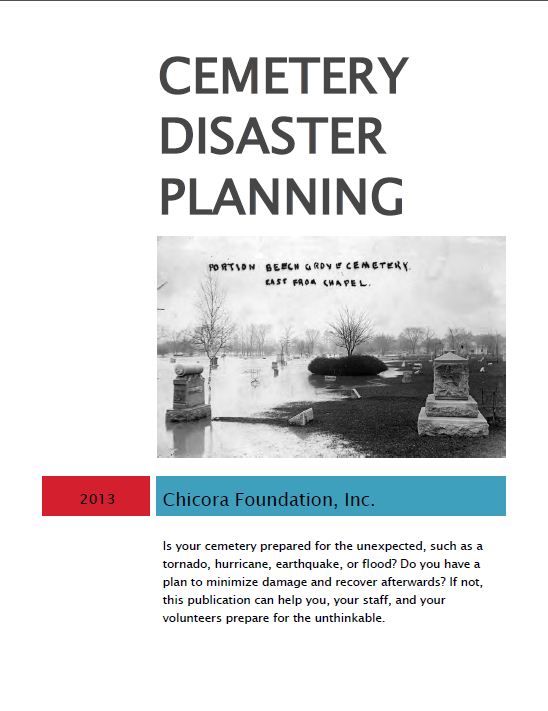Disaster Preparedness Planning
While fires, floods, and earthquakes pose significant threats to historic and cultural properties in California, many other natural and man-made disasters also have the potential to damage or destroy property within the state. Knowing the potential risks, anticipating them, and being properly prepared before, during, and after a disaster could mean the difference between the total loss of a resource and limiting or eliminating the resulting damage.
Essential preparedness planning and mitigation are key factors in ensuring that historic properties are properly identified, evaluated, and treated immediately after a disaster occurs and in the recovery period afterwards. While disasters may be unpredictable, important steps can be taken before a disaster occurs to minimize the threat of damage. Disaster preparedness is everyone’s responsibility.
Although it is important for local governments and jurisdictions to implement planning and mitigation measures before a disaster or emergency occurs, many of these measures should also be implemented proactively by local communities or neighborhood organizations or by individual owners of historic properties.
BE PREPARED
- Compile a list of key emergency contacts, determine which agency or what person is responsible for what activities and make the information widely available. Maintain adequate emergency supplies.
GET TRAINED
- With proper training and knowing what to do in the event of a disaster, emergency responders will be prepared to assist their neighbors and help protect lives and property.
IDENTIFY, EVALUATE AND DOCUMENT RESOURCES
- In spite of the number of resources listed in the California or National Registers, many of California's significant historic and cultural resources have yet to be identified and evaluated. Local surveys are vitally important for disaster preparedness planning.
REGISTER QUALIFIED RESOURCES
- The pre-disaster listing in or a determination of eligibility for listing in the National Register of Historic Places will streamline the environmental and historic preservation review process in the event of any disaster undertaking on the property. This pre-disaster determination may be crucial in how the resource is treated when significant damage is incurred as the result of a disaster. Prior listing or determination will provide pre-disaster documentation of the qualified historic property to ensure a proper evaluation in any regulatory process impacting the resource, including the factoring of potential repair costs.
- All resources listed in or determined eligible for the National Register are automatically included in the California Register of Historic Resources.
- Resources listed in or determined eligible for the California Register qualify for a variety of preservation incentives.
PREPARE EMERGENCY PRESERVATION AND RECOVERY PLANS
- Assess vulnerability and determine risks.
- Perform pre-disaster rehabilitation and mitigation work, such as seismic retrofits or flood controls, to reduce potential impacts to historic properties.
- Set aside funds, adopt disaster ordinances, develop strategies and incentive programs to facilitate recovery efforts.
INTEGRATE PRESERVATION PLANNING WITH GENERAL PLANNING
- Incorporate preservation planning into general, specific, downtown, redevelopment, etc. plans; planning and zoning regulations, and design guidelines.
- Develop local incentive programs to facilitate protection of historic resources.
Resources
NPS Disaster Checklist: Preparing Your Historic Resources for Disaster
California Office of Emergency Services (Cal OES)
National Trust for Historic Preservation - Disaster Preparation and Response
EARTHQUAKES
OES Earthquake Preparedness Program
Earthquake Bolt + Brace Program
How to Prepare for an Earthquake - FEMA
Cómo prepararse para un terremoto - FEMA
Seismic Retrofits Exclusion from Assessment
Planning a seismic retrofit improvement to your property? This letter from the State Board of Equalization of July 2010 summarizes the changes to the new construction exclusion for seismic safety improvements. The letter includes a sample exclusion claim form for local county assessors. Specific forms for each county can be found on most county assessor web sites. If the form is not available on your county assessor's web site ask for Exclusion Form BOE-64.
State Board of Equalization Letter to County Assessors
Cemetery Disaster Planning Booklet

Chicora Foundation out of Columbia South Carolina has made this Cemetery Disaster Planning Booklet available for use. This booklet provides immediate advice on why and how to prepare a disaster plan for your cemetery, reviewing some of the more common cemetery problems, including hurricanes, tornadoes, flooding, and vandalism. It provides comprehensive and up-to-date information on recovery techniques, including FEMA funding.
